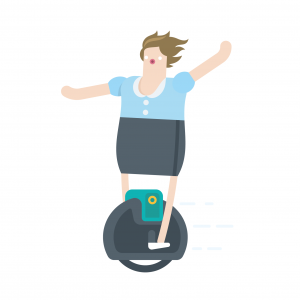Resilience: It’s More Than Just ‘Bouncing Back’
In his second blog on happiness, and how we can make changes to improve it, Mark Swain talks about Resilience.
If I had a pound for every time someone has used the word ‘resilience’ in 2017, I would be a very rich man. Along with ‘neuroscience’ and ‘digital’ it’s one of the most fashionable business words around. We’re using it in many ways, mostly to describe what senior business people need in order to survive and thrive. And in common parlance, it’s used to describe the way people bounce back from setbacks.
I have a big problem with this idea of ‘bounce-back-ability’. For me, it sounds like you have to take a blow, hit the deck and then spring back up as if nothing happened. But life isn’t like that, and this kind of definition makes resilience seem one-dimensional, when it patently isn’t. Instead of taking the hits, and having to bounce back, shouldn’t you try harder to avoid them in the first place? Isn’t it just as important to swerve or slip what’s coming, like a boxer bobbing and weaving to dodge punches or soften the blow? Think of a tree that bends and bows in the wind. If it stood tall and rigid, inflexible and unwavering, high winds would make it snap – flexibility allows it to survive even the most ferocious of storms. You need to be able to bounce, bend and bow, and that’s why I say resilience is multi-dimensional.
Assuming you’re happy with resilience being multi-dimensional, I think we need to step back and find a better definition. That’s why I asked Jeremy Snape (former England international cricketer, and founder of the brilliant Sporting Edge high performance development services for business, sport and education) how he describes resilience. This is what he offered:
‘Resilient people have a clear goal of what they want to achieve or how they want to be perceived in the future and are able to withstand untold criticism, setbacks, distractions and failure to achieve their quest. They have the motivational fuel to stay committed in adversity and find ways to adapt and grow stronger and wiser each day. They judge themselves by their short term choices and do the right things in the right way at the right time – resilient people don’t pick the easiest path, but take pride in their striving towards their goal.’Jeremy Snape
Don’t you think it’s interesting that he starts by saying ‘resilient people have a clear goal’? Again, it’s presenting resilience as being about more than recovering from setbacks. It’s a pretty broad topic, and one you have to explore for yourself. There isn’t a ‘one size fits all’ approach, so avoid looking for a quick fix or resiliency toolkit. Drawing on my own experience, I’d simply recommend three things:
Define
Define your goals, your quest, your magnetic north – and follow your inner compass that defines your values and helps you get there in an authentic way. For me, that’s the best way to stay motivated and create this idea of ‘realistic optimism’, a conscious state where you’re happy and confident you can both self-improve and influence your own outcomes.
Develop
Develop your tolerance of frustration, displeasure, issues, ambiguity, uncertainty, change, minor stresses and your intolerance of the negatives like unattainable expectations (meaning those minus a plan or requiring some kind of improbable event) and procrastination (which only makes problems fester or get bigger). Put simply, this tolerance or intolerance makes you better able to deal with the bigger problems that will happen to all of us.
Deploy
Deploy some obvious tactics that helps the body support the mind – the easily controllables like better diet, adequate sleep, more exercise, relaxation techniques and holistic therapy. Personally, I loathe the gym. Instead I challenge myself to exercise doing things I find difficult or challenging, like swimming (I’m more brick than fish) or sports refereeing (which is tough to do, and frankly just toughens me up!). That way I’m stretching myself both physically and mentally, which I find rewarding and enjoyable. I’d also suggest you read the excellent Hello Grads articles on Finding the Balance.

This blog is very ‘me’, in the sense that I’m quite philosophical about life, but I’m always looking for the practical – ways I can use my thinking and start doing. And that’s how I suggest you approach resilience. Do at least some thinking, and then start doing. Just please don’t ever describe resilience as ‘bounce-back-ability’… It drives me nuts 🙂
Read Mark’s next Happiness blog tomorrow:
PRIME: Image (self and projected)
See more from Mark Swain:
PRIME: Personality: The Way to Find the Work You Love
How to get to know your personality, what really makes you tick, and how to use that self-awareness to find work you’ll really enjoy
For Those Shrinking Violets
Top tips for introverts, and for extroverts who want to better understand the introverts you know
Mark Swain
Director of Partnerships at Henley Business School
About Mark Swain
Mark Swain will be one of our regular contributors at Hello Grads. As Director of Partnerships at the Henley Business School, he delivers high-end learning and leadership development to senior business executives – through training, events and networking.
Mark has enjoyed a career across sales, marketing and many aspects of HR, and he will be talking and writing about some pressing issues for graduates – choosing career direction, recognising what you have to offer, and making yourself stand out in a competitive jobs market.
Contact: mark.swain@henley.ac.uk or www.meritology.me and @meritology
Career:
Director of Partnerships at the Henley Business School
FInstSMM – Fellow of the Institute of Sales & Marketing Management
Fellow at The Learning & Performance Institute
Lead consultant at The Chemistry Group
Education: University of Portsmouth – Economics


Please log in or sign up to comment